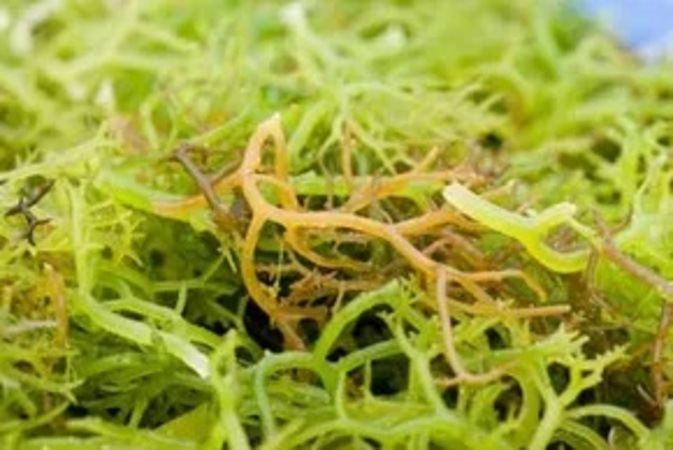
The carrageenan market has experienced steady growth in recent years, driven by its wide range of applications across various industries. Carrageenan is a natural polysaccharide derived from red seaweeds. It is widely used as a food additive, thickening agent, stabilizer, and gelling agent in the food and beverage industry. The market revenue for carrageenan has been on an upward trajectory, with a CAGR of 6.5% during the forecast period of 2025 to 2033, reflecting the increasing demand and expanding application areas. The global market for carrageenan is primarily driven by the growing demand for processed and convenience foods. Carrageenan's ability to enhance texture, improve mouthfeel, and stabilize emulsions makes it a popular ingredient in dairy products, sauces, dressings, and processed meats. Additionally, the rising consumer preference for natural and plant-based ingredients further fuels the demand for carrageenan as it is derived from a sustainable and renewable source. Another significant driver for the carrageenan market is the increasing utilization in the pharmaceutical and cosmetics industries. Carrageenan's unique properties, such as its ability to form gels, stabilize suspensions, and provide controlled release in pharmaceutical formulations, make it an essential ingredient in various pharmaceutical products. In the cosmetics industry, carrageenan is used in skincare products, hair care products, and personal care items due to its emulsifying and moisturizing properties. Furthermore, the expanding applications of carrageenan in the pet food industry contribute to market growth. Carrageenan is used as a binding agent and thickener in pet food products, providing texture, palatability, and improved stability. With the growing pet population and increasing pet humanization trends, the demand for high-quality pet food is rising, thereby boosting the demand for carrageenan.

Increasing Demand for Natural and Plant-Based Ingredients
The demand for natural and plant-based ingredients in various industries, including food, pharmaceuticals, and cosmetics, is a key driver for the carrageenan market. Consumers are increasingly seeking healthier and more sustainable alternatives in their products, which has led to a growing preference for natural ingredients. Carrageenan, derived from red seaweeds, fits this requirement as a natural and renewable ingredient. Its wide range of functionalities, such as gelling, thickening, and stabilizing properties, makes it a versatile choice for manufacturers. For example, in the food industry, carrageenan is used as a natural thickener and stabilizer in dairy products, sauces, and processed meats. The rising consumer demand for natural and plant-based ingredients acts as a strong driver for the carrageenan market.
Growth in the Processed Food Industry
The processed food industry is experiencing significant growth globally, which positively impacts the carrageenan market. Processed foods often require additives to enhance their texture, stability, and shelf life. Carrageenan, with its gelling and thickening properties, is widely used as a food additive in processed food products. For instance, it helps maintain the desired texture in dairy products like yogurt and ice cream and prevents syneresis in processed meats. As the consumption of processed foods continues to rise due to factors such as changing lifestyles and increasing urbanization, the demand for carrageenan as a food additive also grows.
Expansion of Pharmaceutical and Cosmetics Industries
The pharmaceutical and cosmetics industries are key drivers for the carrageenan market. In pharmaceutical applications, carrageenan is utilized for its ability to form gels, stabilize suspensions, and provide controlled release in drug formulations. It finds application in products such as tablets, capsules, and topical gels. The increasing prevalence of chronic diseases, coupled with the demand for advanced drug delivery systems, drives the utilization of carrageenan in the pharmaceutical sector. In the cosmetics industry, carrageenan is valued for its emulsifying, thickening, and moisturizing properties. It is used in skincare products, hair care products, and personal care items to improve texture and enhance product performance. The growing focus on personal grooming and the rising demand for natural and sustainable cosmetics contribute to the expansion of the carrageenan market in the cosmetics sector.
Risks of Seaweed Supply Chain Disruptions
One restraint that can impact the carrageenan market is the risk of seaweed supply chain disruptions. Carrageenan is derived from red seaweeds, which are harvested from oceans and coastal areas. The availability and quality of seaweed can be affected by various factors such as weather conditions, natural disasters, and environmental changes. These factors can disrupt the seaweed supply chain, leading to fluctuations in the availability and pricing of carrageenan. For example, adverse weather events like storms or excessive rainfall can damage seaweed crops, resulting in lower yields and potentially affecting the supply of carrageenan. In addition, environmental factors such as pollution or changes in seawater conditions can impact the growth and quality of seaweed, further posing challenges to the carrageenan market. While efforts are being made to improve seaweed farming practices and sustainability, the inherent vulnerability of seaweed cultivation to external factors remains a potential restraint for the carrageenan market. Ensuring a stable and sustainable seaweed supply chain through effective management and mitigation strategies is crucial to address these potential disruptions and maintain a consistent supply of carrageenan to meet market demand. Seaweed farming practices are known to be influenced by weather patterns and environmental factors. For instance, research studies have highlighted the impact of climate change on seaweed cultivation and highlighted the need for sustainable practices to mitigate risks (Source: Journal of Applied Phycology - "Effects of climate change on seaweed cultivation in temperate regions: the example of alginates in Brittany (France)."
Alcohol Precipitation Dominates the Processing Technologies
The Carrageenan market is driven by various processing technologies, namely alcohol precipitation, gel press, and semi-refined methods. Among these processing technologies, alcohol precipitation led in terms of revenue in 2024, the market also exhibits the highest CAGR during the forecast period of 2025 to 2033. This method involves the use of alcohol to separate carrageenan from impurities, resulting in high-quality carrageenan with excellent gel strength. Its efficiency in carrageenan production and ability to meet the demand for various applications have contributed to its significant revenue share and growth prospects. Alcohol precipitation, with its highest revenue and growth potential, sets the pace for market expansion. Gel press technology offers unique properties for specific applications, and the semi-refined segment provides a cost-effective solution. By recognizing the market demand for different processing technologies, stakeholders can strategically align their operations to optimize revenue growth and capture market opportunities in the Carrageenan industry.
Kappa Carrageenan Dominated the Market by Product Type
The Carrageenan market is segmented based on product types, namely Kappa, Iota, and Lambda carrageenan. Among these product segments, Kappa carrageenan holds the highest revenue share, driven by its extensive usage in the food industry. Kappa carrageenan, derived primarily from Eucheuma cottonii and Eucheuma spinosum seaweeds, offers excellent gelling properties and stability in dairy products, meat processing, and confectionery applications. Its ability to form rigid and brittle gels makes it ideal for enhancing the texture, stability, and mouthfeel of various food products. While Kappa carrageenan dominated in terms of revenue in 2024, Iota carrageenan showcases the highest CAGR during the forecast period of 2025 to 2033. Iota carrageenan, sourced from Eucheuma denticulatum seaweed, exhibits superior water-holding and thickening properties. It finds extensive applications in the dairy industry, specifically in the production of soft-set and creamy products like puddings, custards, and yogurts. Additionally, Iota carrageenan is widely used in the pharmaceutical and cosmetic industries due to its gelling and stabilizing characteristics.
APAC Leads the Revenue and Growth
Asia Pacific held a prominent position in the Carrageenan market, accounting for the highest revenue percentage in 2024. The region's dominance can be attributed to factors such as the presence of major carrageenan producers, favorable climatic conditions for seaweed cultivation, and the growing demand for carrageenan-based products in the food and beverage industry. Countries like Indonesia, the Philippines, and China are key contributors to the market in this region. North America and Europe also play significant roles in the Carrageenan market. In North America, the United States stands out as a major consumer and producer of carrageenan, primarily driven by the demand for processed food products and the presence of a well-established food and beverage industry. Europe, particularly countries like France, Spain, and the United Kingdom, showcases a growing demand for carrageenan owing to its wide usage in the dairy, confectionery, and personal care sectors. In terms of the region with the highest CAGR, the Asia Pacific region leads the way during the forecast period of 2025 to 2033. The increasing population, changing dietary patterns, and growing consumer awareness regarding the benefits of natural ingredients in food and personal care products are driving the demand for carrageenan in this region. Moreover, the presence of a large customer base and the expansion of various end-use industries fuel the growth of the Carrageenan market in Asia Pacific.
Market Competition to Intensify During the Forecast Period
The Carrageenan market is highly competitive, with several key players operating on a global scale. These companies strive to maintain their market position by adopting various strategies, including product innovation, strategic partnerships, and expansion into new markets. The top players in the Carrageenan market include Cargill, Inc., CP Kelco, FMC Corporation, DuPont de Nemours, Inc., and Ingredients Solutions Inc. These companies have a strong presence in the market and are actively involved in the production and supply of carrageenan-based products. They focus on continuous research and development to introduce innovative carrageenan solutions that cater to the evolving needs of different industries. Furthermore, sustainability and traceability have become key focus areas for carrageenan manufacturers. They actively engage in responsible sourcing practices to ensure the sustainability of seaweed resources and promote eco-friendly production processes. Additionally, they work closely with farmers and local communities to improve farming practices and support the development of sustainable seaweed cultivation.
Historical & Forecast Period
This study report represents analysis of each segment from 2023 to 2033 considering 2024 as the base year. Compounded Annual Growth Rate (CAGR) for each of the respective segments estimated for the forecast period of 2025 to 2033.
The current report comprises of quantitative market estimations for each micro market for every geographical region and qualitative market analysis such as micro and macro environment analysis, market trends, competitive intelligence, segment analysis, porters five force model, top winning strategies, top investment markets, emerging trends and technological analysis, case studies, strategic conclusions and recommendations and other key market insights.
Research Methodology
The complete research study was conducted in three phases, namely: secondary research, primary research, and expert panel review. key data point that enables the estimation of Carrageenan market are as follows:
Market forecast was performed through proprietary software that analyzes various qualitative and quantitative factors. Growth rate and CAGR were estimated through intensive secondary and primary research. Data triangulation across various data points provides accuracy across various analyzed market segments in the report. Application of both top down and bottom-up approach for validation of market estimation assures logical, methodical and mathematical consistency of the quantitative data.
| ATTRIBUTE | DETAILS |
|---|---|
| Research Period | 2023-2033 |
| Base Year | 2024 |
| Forecast Period | 2025-2033 |
| Historical Year | 2023 |
| Unit | USD Million |
| Segmentation | |
Processing Technology
| |
Function
| |
Product
| |
Application
| |
|
Region Segment (2023-2033; US$ Million)
|
Key questions answered in this report